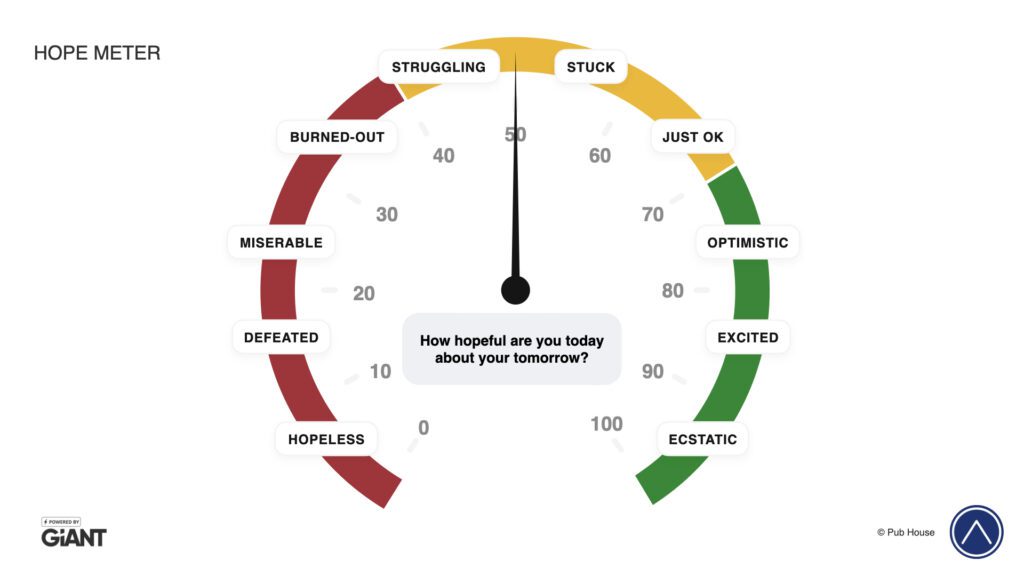Inside a transformational retreat for Virginia’s private college presidents — and the tool helping leaders measure what really matters
When 20 private college presidents from across Virginia gathered this fall, they came for more than a dashboard review and budget briefing.
They came to reconnect: with one another, with their personal mission, and with something harder to quantify but essential to sustain:
Hope.
Hosted by the Council of Independent Colleges in Virginia (CICV) and guided by Leaders Rising Network, this intimate retreat was created in response to a growing need: presidents stepping into turbulent roles, often post-pandemic, in a sector still reeling from uncertainty. The goal was clear: help leaders reclaim their sense of purpose in the face of constant complexity and leave with language, tools, and community they could carry home.
“Presidents are leading through more volatility, with less margin,” said Aaron Lee, Leaders Rising Network CEO. “We weren’t trying to give them more content. We were there to remind them why they lead.”

The Problem Beneath the Surface
Although strategic challenges are well-documented (such as demographic cliffs, budget pressures, and shifting enrollment patterns), there’s another, quieter crisis growing behind closed doors: leader disconnection.
- Many presidents are newer to the role.
- Others are the last point of stability in a sea of executive turnover.
- Most are managing institutions and teams while carrying deep personal fatigue.
According to CICV data at the event, 16 of the presidents in the room had started post-COVID and multiple new presidents this year. When the group considered average tenure without its longest-serving leaders, it dropped to just 3.6 years.
“College presidents aren’t just navigating complexity. They’re exhausted. They need space to reflect, not just perform,” Lee noted.
Leading with Hope
The retreat was themed “Leading with Hope: Reclaiming Purpose in Turbulent Times.”
The format? No PowerPoint decks. No “best practices” lectures. Instead:
- Story-driven sessions
- Guided conversations at dinner
- One powerful tool to spark individual insight and shared language: the Hope Meter
The Hope Meter: A Simple Tool for a Deep Need
At its core, the Hope Meter is a visual framework that invites leaders to name, assess, and reflect on their emotional and motivational state.
The Hope Meter invites you to represent your level of hope, energy, and forward vision as a leader on a scale from 0 to 100.

Participants were invited to consider their overall sense of hope, as well as specific relationships that needed hope.
“No one needed training on what hope is. They needed permission to talk about where they actually are—and why that matters,” Lee said.
The Hope Meter isn’t just self-awareness for awareness’s sake. It’s diagnostic. It opens space for conversation that presidents don’t usually get to have with each other.
“The moment we introduced it, the room changed,” Dr. Tom Nebel shared. “You could see the shift from posture to presence.”
From Surface to Substance
One president said it plainly:
“I’ve known some of you for a decade. But after today, I feel like I really know you.”
That reflection came after the group’s dinner, a curated meal where each table was guided by prompts like:
- What gives you hope in your work today?
- What’s one thing that’s weighing on you that no one sees?
Another president added,
“We definitely enjoyed it. The info they presented was very helpful… it was great.”
The Impact: What Shifted
Presidents walked away not only with deeper connection—but with tools and language to bring back to their campuses.
They named several takeaways:
Clarity on what’s within their control — through a framework called the Influence Map, participants were invited to separate what they can do from what they can’t, helping reduce emotional noise.
Language to name emotional reality — The Hope Meter now functions as a simple check-in for use with teams, boards, or even in presidential journaling.
A rhythm of reflection — What started as a retreat is becoming a rhythm: several presidents committed to reconnecting quarterly for short, peer-led conversations.
Trust that transcends institutions — The retreat deepened bonds not just among peers, but across campuses, as presidents moved beyond institutional competition and toward shared mission.
A Model Worth Repeating
For Leaders Rising Network, this was more than a one-time event.
“This retreat was a prototype for how we believe leadership development should look in higher ed,” Aaron Lee said. “Human-first. Hope-centered. Deeply practical.”
Retreats provide a foundation on which we build simple, repeatable systems. CICV leadership is exploring pathways to continue serving its members alongside the Leaders Rising Network team.
Other networks can explore similar gatherings with the same goal: equip leaders to lead from identity, not just urgency.
And while tools like the Hope Meter or Influence Map are simple, their power is in how they’re used: not to manage performance, but to invite presence and perspective.
Final Word
In a sector known for its intellect and analysis, this retreat reminded leaders that it’s okay — and essential — to care for the person behind the title.
“Hope doesn’t eliminate the hard,” said Aaron Lee. “But it anchors you in what’s still possible. That’s what we’re fighting for.”
For CICV, the retreat was a bold experiment that paid off, not with applause, but with alignment.
For the presidents, it was more than great.
It was necessary.
💬 Ready to Rediscover Hope?
We help executive leaders and teams align their leadership and build culture systems that actually change how teams work together. Let’s talk about what that could look like for you.



